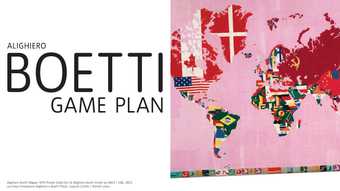28 February – 27 May 2012 (Press view: 27 February 2012)
Tate Modern, Level 4
One of the most influential Italian artists of the twentieth century, Alighiero Boetti (1940-1994) will be the subject of a major exhibition at Tate Modern in spring 2012. Alighiero Boetti: Game Plan will be the first large-scale retrospective of Boetti’s work to be held outside Italy in over a decade highlighting his often playful exploration of numeric, linguistic and classificatory systems, as well as his engagement with the people and politics of Afghanistan.
Boetti has most commonly been associated with the Italian Arte Povera artists of the late 1960s. While this exhibition begins with his Arte Povera objects made from everyday materials, including Stack 1966 and Little Coloured Sticks 1968, it also reveals his early scepticism about art movements through such works as his mock Manifesto 1967. In the late 1960s Boetti began to explore the figure of the artist, showing how it embodied the dual roles of divine shaman and public showman. He went on to represent himself as a pair of twins and change his name to Alighiero E Boetti [Alighiero and Boetti]. Alongside these early self portraits, the exhibition will also include the late Self-Portrait 1993, a life-size bronze cast of the artist spraying his head with a hose, never seen before in the UK.
Alighiero Boetti: Game Plan will highlight Boetti’s engagement with geopolitics and his travels to Ethiopia, Guatemala and Afghanistan. In 1971 Boetti set up the One Hotel in Kabul and began to work with local craftswomen to create large embroideries. The most famous of these were the Mappa, many of which will be brought together at Tate Modern. These world maps, in which each country is coloured with its national flag, record political change across the globe from 1971 to 1994, charting the independence of African states and the break-up of the USSR. The exhibition also explores the ways in which Boetti worked with exiled Afghans to articulate their political ambitions during the years of the Soviet occupation.
Boetti’s lifelong fascination with games, numbers, words, dates and sequences will also be a focus, evident in works such as Dama 1967, which uses a chequerboard pattern to evoke an absurd domino-like game, and Ordine e disordine 1973 which comprises 100 multicoloured word squares randomly arranged on the wall. The exhibition will feature several biro drawings in which Boetti’s favourite phrases are encoded, the embroideries The Thousand Longest Rivers in the World 1978 and The Hour Tree 1979, and a set of rugs from 1993 whose patterns are based on numeric systems. The exhibition will also look at Boetti’s collaborations with young people, including jigsaws based on watercolour paintings of aeroplanes, counting books made with his daughter, and grids of faces which were completed by children.
Alighiero Boetti was born in Turin in 1940 and moved in the early 1970s to Rome. He has been the subject of solo exhibitions including at the Kunsthalle Basel (1978), Galleria CIvica d’Arte Moderna e Contemporanea, Turin (1996) and the Whitechapel Gallery, London (1999).
Alighiero Boetti: Game Plan is curated by Mark Godfrey, Curator, Tate Modern with Kasia Redzisz, Assistant Curator, Tate Modern. This exhibition is a collaboration with the Reina Sofia, Madrid, where it will be shown from 5 October 2011 to 5 February 2012, and The Museum of Modern Art, New York, where it will travel in Summer 2012.

